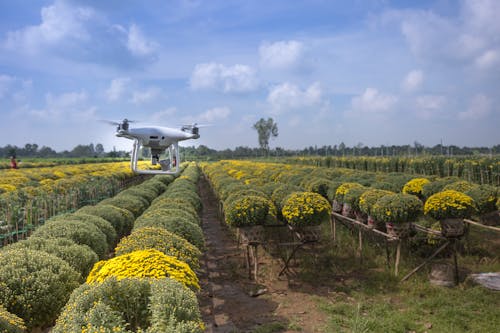🚁 The Role of Drones, Sensors, and AI in Precision Agriculture
By - Blink AI Team / First Created on - July 17, 2025

Introduction: Agriculture Gets Smart
Farming is no longer just about tractors and toil — it’s about tech and timing. In the era of smart farming, precision agriculture is leading the way. At its core, it’s about giving farmers real-time insights into their fields — powered by AI, sensors, and drones.
This isn’t a trend — it’s a revolution. Precision agriculture is making farming more efficient, less wasteful, and deeply data-driven. Let’s dive into how these technologies work together to reshape the future of food production.
What Is Precision Agriculture?
Precision agriculture refers to data-based decision-making in farming. Rather than treating entire fields the same, farmers use tech tools to:
-
Analyze soil conditions
-
Monitor crop health
-
Apply resources only where and when they’re needed
The result? Higher yields, lower input costs, and reduced environmental impact.
🚁The Power of Drones in Modern Farming
Aerial Eyes on the Ground
Drones are one of the most disruptive technologies in agriculture today. Equipped with high-resolution cameras and multispectral sensors, they can scan large areas of farmland in minutes.
Key Functions of Drones:
-
Field Mapping: Create 3D maps of the terrain and soil variability
-
Plant Health Monitoring: Use NDVI (Normalized Difference Vegetation Index) to assess plant health
-
Pest and Disease Detection: Spot stress or early signs of infestation
-
Precision Spraying: Deliver fertilizers or pesticides only where needed
Example:
A farmer using a DJI Agras drone in Punjab can cover 30 acres in under 2 hours, identifying water stress areas and applying nutrients only where required — saving both time and resources.
A farmer using a DJI Agras drone in Punjab can cover 30 acres in under 2 hours, identifying water stress areas and applying nutrients only where required — saving both time and resources.
🧠 AI: The Brain Behind the Data
From Raw Data to Smart Decisions
Drones and sensors collect massive amounts of data — but data alone isn’t useful. That’s where Artificial Intelligence comes in.
AI algorithms analyze this information to:
-
Predict crop yields
-
Recommend seeding and harvesting schedules
-
Detect anomalies before they become costly
-
Advise on irrigation, nutrient levels, and disease risks
Real-World Application:
IBM Watson Decision Platform for Agriculture uses AI models trained on historical and real-time data to suggest day-by-day decisions for farmers. It’s like having a virtual agronomist on call 24/7.
🌱 Smart Sensors: Ground-Level Intelligence
Know Your Soil, Weather, and Plants
Sensors placed in the field collect hyper-local data like:
-
Soil moisture
-
Temperature
-
pH levels
-
Rainfall
-
Sunlight intensity
These sensors work 24/7, providing minute-by-minute updates to cloud platforms. Combined with AI, this information helps automate decisions, like:
-
When to irrigate (and how much)
-
When to apply fertilizers
-
When to deploy drones for aerial scans
Example:
A vineyard in California uses CropX sensors to reduce irrigation water usage by 25%, while improving grape yield and quality.
A vineyard in California uses CropX sensors to reduce irrigation water usage by 25%, while improving grape yield and quality.
🔄 The Integrated System
How They Work Together
Here’s a real-world scenario:
-
Soil sensors detect low moisture in a section of the field.
-
Drones fly over and capture NDVI images showing plant stress.
-
AI software analyzes the data and identifies nutrient deficiency as the cause.
-
The system alerts the farmer, recommending targeted spraying.
-
A spraying drone is deployed, treating only the affected area.
This loop of feedback and action forms the backbone of precision farming.
🌍 Why It Matters
✅ Higher Productivity
With accurate data, farmers can increase yields by treating each area optimally.
✅ Lower Input Costs
Less water, fewer chemicals, more efficiency.
✅ Environmental Sustainability
Precision use of resources means less runoff, less pollution, and healthier soil.
✅ Climate Adaptability
AI helps predict weather patterns, making farms more resilient to climate change.
Challenges to Overcome
While promising, adoption faces a few hurdles:
-
Cost of Equipment: Still high for small farmers
-
Connectivity: Requires internet access and infrastructure
-
Technical Skills: Farmers need training to use these systems effectively
-
Data Ownership: Privacy and usage rights for farm-collected data need regulation
Conclusion
Precision agriculture isn’t just a buzzword — it’s a solution to one of humanity’s greatest challenges: feeding a growing population sustainably.
Drones provide the vision.
Sensors provide the pulse.
AI provides the brain.
Together, they form a new generation of farming — one where every seed, drop of water, and ray of sunlight is maximized.
The fields of the future aren’t just greener. They’re smarter.
Sensors provide the pulse.
AI provides the brain.
Together, they form a new generation of farming — one where every seed, drop of water, and ray of sunlight is maximized.